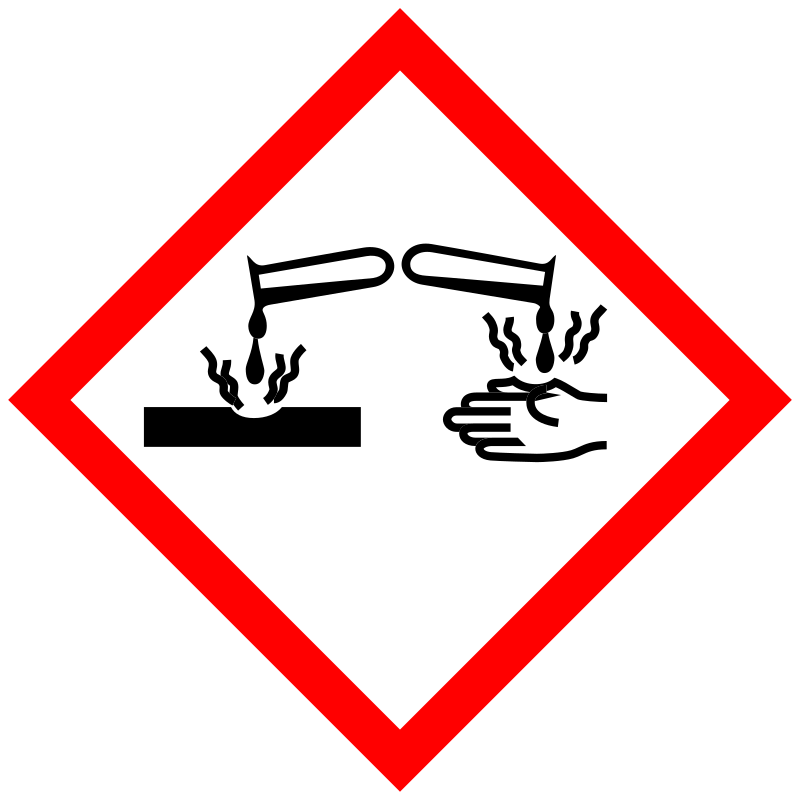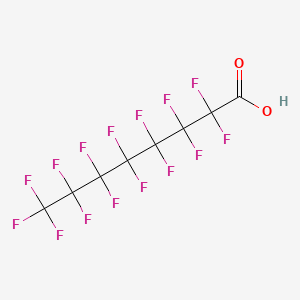D0226 | Perfluorooctanoic acid
| Toxicity | Dose | Time | Species | Model | Method | Action | Positive criterion | Reference |
|---|---|---|---|---|---|---|---|---|
| MITOCHONDRIAL DYNAMICS | In utero exposure (GD 1–17) to 1 mg/kg bodyweight dam | Post-natal day 91 mouse livers | 247 | |||||
| Pictogram | Signal | Statements | Precautionary Statement Codes |
|---|---|---|---|
   |
Danger |
H302: Harmful if swallowed [Warning Acute toxicity, oral] H318: Causes serious eye damage [Danger Serious eye damage/eye irritation] H332: Harmful if inhaled [Warning Acute toxicity, inhalation] H351: Suspected of causing cancer [Warning Carcinogenicity] H360D: May damage the unborn child [Danger Reproductive toxicity] H362: May cause harm to breast-fed children [Reproductive toxicity, effects on or via lactation] H372: Causes damage to organs through prolonged or repeated exposure [Danger Specific target organ toxicity, repeated exposure] |
P201, P202, P260, P261, P263, P264, P270, P271, P280, P281, P301+P312, P304+P312, P304+P340, P305+P351+P338, P308+P313, P310, P312, P314, P330, P405, and P501; (The corresponding statement to each P-code can be found at the GHS Classification page.) |
   |
Danger |
Aggregated GHS information provided by 153 companies from 9 notifications to the ECHA C&L Inventory. Each notification may be associated with multiple companies. H302 (94.77%): Harmful if swallowed [Warning Acute toxicity, oral] H314 (35.95%): Causes severe skin burns and eye damage [Danger Skin corrosion/irritation] H318 (68.63%): Causes serious eye damage [Danger Serious eye damage/eye irritation] H332 (64.05%): Harmful if inhaled [Warning Acute toxicity, inhalation] H351 (64.05%): Suspected of causing cancer [Warning Carcinogenicity] H360 (64.05%): May damage fertility or the unborn child [Danger Reproductive toxicity] H362 (64.05%): May cause harm to breast-fed children [Reproductive toxicity, effects on or via lactation] H372 (64.05%): Causes damage to organs through prolonged or repeated exposure [Danger Specific target organ toxicity, repeated exposure] Information may vary between notifications depending on impurities, additives, and other factors. The percentage value in parenthesis indicates the notified classification ratio from companies that provide hazard codes. Only hazard codes with percentage values above 10% are shown. |
P201, P202, P260, P261, P263, P264, P270, P271, P280, P281, P301+P312, P301+P330+P331, P303+P361+P353, P304+P312, P304+P340, P305+P351+P338, P308+P313, P310, P312, P314, P321, P330, P363, P405, and P501; (The corresponding statement to each P-code can be found at the GHS Classification page.) |
 |
Warning |
The GHS information provided by 1 company from 1 notification to the ECHA C&L Inventory. H315 (100%): Causes skin irritation [Warning Skin corrosion/irritation] H319 (100%): Causes serious eye irritation [Warning Serious eye damage/eye irritation] H335 (100%): May cause respiratory irritation [Warning Specific target organ toxicity, single exposure Respiratory tract irritation] |
P261, P264, P271, P280, P302+P352, P304+P340, P305+P351+P338, P312, P321, P332+P313, P337+P313, P362, P403+P233, P405, and P501; (The corresponding statement to each P-code can be found at the GHS Classification page.) |
   |
Danger |
H301: Toxic if swallowed [Danger Acute toxicity, oral] H319: Causes serious eye irritation [Warning Serious eye damage/eye irritation] H331: Toxic if inhaled [Danger Acute toxicity, inhalation] H351: Suspected of causing cancer [Warning Carcinogenicity] H360D: May damage the unborn child [Danger Reproductive toxicity] H372: Causes damage to organs through prolonged or repeated exposure [Danger Specific target organ toxicity, repeated exposure] |
P201, P202, P260, P261, P264, P270, P271, P280, P281, P301+P310, P304+P340, P305+P351+P338, P308+P313, P311, P314, P321, P330, P337+P313, P403+P233, P405, and P501; (The corresponding statement to each P-code can be found at the GHS Classification page.) |
   |
Danger |
H302: Harmful if swallowed [Warning Acute toxicity, oral] H318: Causes serious eye damage [Danger Serious eye damage/eye irritation] H332: Harmful if inhaled [Warning Acute toxicity, inhalation] H351: Suspected of causing cancer [Warning Carcinogenicity] H360: May damage fertility or the unborn child [Danger Reproductive toxicity] H362: May cause harm to breast-fed children [Reproductive toxicity, effects on or via lactation] H372: Causes damage to organs through prolonged or repeated exposure [Danger Specific target organ toxicity, repeated exposure] |
P201, P202, P260, P261, P263, P264, P270, P271, P280, P281, P301+P312, P304+P312, P304+P340, P305+P351+P338, P308+P313, P310, P312, P314, P330, P405, and P501; (The corresponding statement to each P-code can be found at the GHS Classification page.) |
 |
Danger |
H360: May damage fertility or the unborn child [Danger Reproductive toxicity] H372: Causes damage to organs through prolonged or repeated exposure [Danger Specific target organ toxicity, repeated exposure] |
P201, P202, P260, P264, P270, P281, P308+P313, P314, P405, and P501; (The corresponding statement to each P-code can be found at the GHS Classification page.) |
| 2,2,3,3,4,4,5,5,6,6,7,7,8,8,8-Pentadecafluoro-Octanoic Acid | 2,2,3,3,4,4,5,5,6,6,7,7,8,8,8-Pentadecafluorooctanoic acid | 2,2,3,3,4,4,5,5,6,6,7,7,8,8,8-Pentadecafluorooctanoic acid # |
| 335-67-1 | 335-93-3 | 8PF |
| 947VD76D3L | 97812-EP2305685A1 | 97812-EP2305686A1 |
| ACMC-1CN9C | AI3-19341 | AK161799 |
| AKOS005259894 | AS-15245 | BRN 1809678 |
| C7F15COOH | C8HF15O2 | CAS-335-67-1 |
| CCRIS 4386 | CHEBI:35549 | CHEMBL172988 |
| CS-B0915 | CTK1C2449 | DB-048447 |
| DSSTox_CID_11865 | DSSTox_GSID_31865 | DSSTox_RID_78895 |
| DTXSID8031865 | EINECS 206-397-9 | FT-0631976 |
| Fluorad FC-26 (Salt/Mix) | HSDB 7137 | Hexanoyl fluoride, 3,3,4,4,5,5,6,6,6-nonafluoro-2-oxo- |
| Hexanoyl fluoride,3,4,4,5,5,6,6,6-nonafluoro-2-oxo- | IPC-PFFA-8 | IPC-PFFA-8 HG |
| K-7733 | KS-00000VX0 | LS-1215 |
| LS40741 | MCULE-1103416295 | MFCD00004174 |
| NCGC00164448-01 | NCGC00164448-02 | NCGC00164448-03 |
| NCGC00254596-01 | NSC 95114 | NSC-95114 |
| NSC95114 | O617 | Octanoic acid, 2,2,3,3,4,4,5,5,6,6,7,7,8,8,8-pentadecafluoro- |
| Octanoic acid, pentadecafluoro- | P0764 | PERFLUOROOCTANOIC ACID |
| PFOA | Pentadecafluoro-1-octanoic acid | Pentadecafluoro-n-octanoic acid |
| Pentadecafluorooctanoic Acid High Grade | Pentadecafluorooctanoic acid | Pentadecafluorooctanoic acid solution, 100 mug/mL in methanol, analytical standard |
| Pentadecafluorooctanoic acid, 96% | Pentadecafluorooctanoic acid, analytical grade | Pentadecafluorooctanoic acid, analytical standard |
| Pentadecafluorooctanoicacid | Perfluoro-n-octanoic acid | Perfluorocaprylic acid |
| Perfluoroctanoic acid | Perfluoroheptanecarboxylic acid | Perfluorooctanoic Acid High Grade |
| Perfluorooctanoic acid 100 microg/mL in Acetonitrile | Perfluorooctanoic acid, 96% | Q418348 |
| RTR-014034 | SC-13661 | SCHEMBL22556 |
| SNGREZUHAYWORS-UHFFFAOYSA-N | ST24038407 | TR-014034 |
| TRA0098108 | Tox21_300688 | UNII-947VD76D3L |
| W-106771 | Z1270326259 | ZINC6844606 |
| n-perfluorooctanoic acid | perfluorooctylcarboxylic acid |
| CAS Number | 2395-00-8, 301305-73-7, 335-67-1, 335-93-3, 3825-26-1, 864071-08-9 |
| PubChem Compound | 9554 |
| ChEBI | 35549 |
| ChemSpider | 9180 |
| Wikipedia | Perfluorooctanoic acid |

